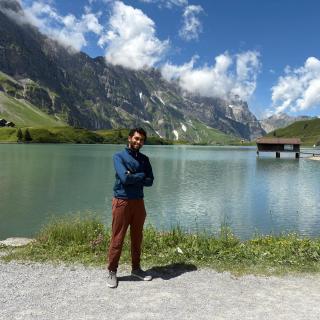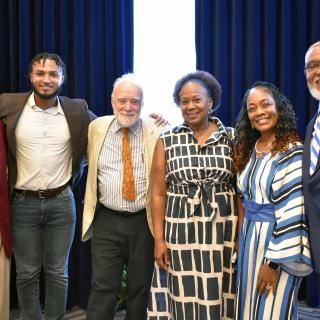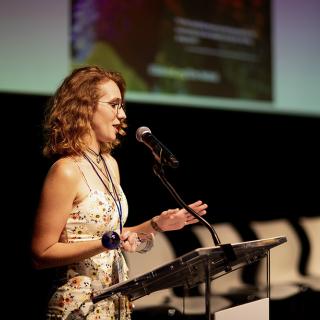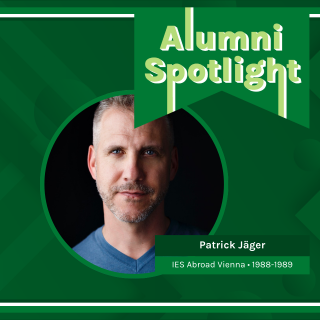Meet Mary Sherman (IES Abroad Vienna 1978-79 | Boston College), Executive Director of TransCultural Exchange, a non-profit organization dedicated to promoting international art and the understanding of world cultures. While studying Studio Art her junior year in Vienna, Mary was encouraged to pursue her passion for art by two of her professors. After graduating from college, she moved to Chicago, staying in touch with Vienna classmates, Caroline Anderson, Wanda Bubriski, and Terry Jelsing. As time passed, each pursued their own dream in the arts, although their paths continued to cross—and they hope they always will. Mary’s own works, which push the definition of painting into the realm of space and sound, have been shown around the world.
Read on to discover how Mary’s experience in Vienna served as a catalyst for her career as an artist and her advice for students today.
IES Abroad: What inspired you to study studio art in Vienna, and how did it impact your study abroad?
Mary Sherman (MS): I grew up on the U.S. territory, Midway Island, where my father was a Navy pilot and Communications Officer. Later we moved to California and then Northern Virginia where, one day, as a high school student, I went to see a painting demonstration. I was completely captivated, and I decided on the spot that that was what I wanted to do for the rest of my life. Thankfully, I was supported in that desire by a special program at the Smithsonian’s Portrait Gallery. After that, there was no turning back.
As for Vienna, the decision to go there was mainly based on my great-grandparents being from Austria and my own wanderlust. Without a doubt, though, the experience was more than I could’ve ever hoped for. At the time, our art teachers were Professor Eric Huber and the artist Mario DeCelve (both, I later learned, took over teaching the art classes from IES Abroad’s co-founder and artist, Clarence Giese—whom I’m very sorry I never met). Those teachers’ faith in me—in all of us—gave me faith in myself. To be an artist is not an easy life. There are very few guarantees—including the most basic: a regular pay check—but those teachers’ belief in me carried me through many tough times.
IES Abroad: When did you decide to pursue art professionally? How did you make it happen after graduation?
MS: At the age of 17, I decided to be an artist. I even left college at one point to study at New York’s Art Students League. But after I finally graduated, I continued to paint and worked numerous odd jobs in Boston and then Chicago, where I one day got a call from Wanda, who asked me if I could house some of her friends from Vienna who were traveling throughout the United States as part of their architectural studies. (Architecture and Art History were Wanda’s expertise.) I was happy to do this, and during the course of their stay they asked if I’d be interested in an exchange show with artist friends of theirs in Vienna. I naturally said yes and collected other artist friends of mine in Chicago to do so. We found a space, held an auction and dance party to raise the shipping funds, and then…well, we just made it all happen, including housing the dozens of artists from Vienna.
The result was the start of what has become the international nonprofit that I now run, TransCultural Exchange (TCE). And, like all TCE’s projects since then, that first project, entitled Reverse Angle, was international, transdisciplinary, and cross-cultural. It included works by about 70 artists from Chicago and Vienna (which were first shown at Chicago’s historic Ludwig Drum Factory and, later, at Vienna’s WUK Kunsthalle), a literary reading at Café Tete a Tete, a show of films by filmmakers from both cities at Facets Multimedia Centre, and a catalog by ACM (Another Chicago Magazine, which included a reprint of a film script by Wim Wenders of the same title as the show). All this was arranged and created solely by the artists involved and their friends, including the Chicago musician Nicholas Tremulis.
Tell us a little more about TransCultural Exchange.
MS: I revived TransCultural Exchange later in New York with a show at the Trans Hudson Gallery and, to date, we have created over 350 projects around the globe, most notably participating in the London Biennale and producing The Tile Project (which resulted in 22 permanent public art works installed around the world), and The Coaster Project (which resulted in 99 international exhibitions and 10,000 artist-designed coasters given away in bars, cafes, and restaurants around the world).
Today, TransCultural Exchange is, perhaps, best known for its biennial International Conferences on Opportunities in the Arts, which was launched in 2007 and is the only international conference of its kind. Caroline and I had actually reconnected a few years before these conferences. She was instrumental in the success of the Tile Project and, for the first conferences, she served as TransCultural Exchange’s assistant director.
I’m very proud that—on less than a shoestring, our 30 years of service have earned the organization considerable acclaim, support and awards from institutions such as the United Nations Educational Scientific and Cultural Organization (UNESCO), the National Endowment for the Arts (NEA), the Asian Cultural Council, the Netherland-America Foundation, the Austrian Cultural Forum, and numerous consulates, among others.
IES Abroad: Your art has been exhibited around the world, and you’ve been involved in the art world in other ways, too. Tell us about that.
MS: I’ve been very fortunate. I’ve had the good fortune to have received three Fulbright Senior Special grants and to have been an artist-in-resident at MIT, the Taipei Artist Village, and–this summer–at the Cité internationale des arts in Paris. Equally great is to have been able to travel with my work for exhibitions at Taipei's Kuandu Museum of Fine Arts, Trondheim’s Academy of Fine Arts at the University of Science and Technology, Montreal’s Biennale of Electronic Art (BIAN), Seoul's Kwanhoon Gallery, New York's Trans Hudson Gallery, and APO-33 in Nantes, France. I’m also really pleased that a work of mine was part of a concert line-up at Beijing’s Central Conservatory. This crossing of boundaries between worlds (in this case the music and art worlds) interests me greatly. But, one of my favorite exhibition memories is showing with Caroline at the Plains Art Museum in Fargo at the request of the director at the time, Terry Jelsing. And for that show, Wanda also took part by writing an essay for the catalog I made for the exhibit. It was a wonderful experience.
In addition to pursuing my career as an artist, I’ve also managed to survive by working as an art critic for such publications as The Chicago Sun-Times, The Boston Globe, and ARTnews. Today, I’m lucky to teach at Boston College and Northeastern University and, in 2010, I returned to MIT to serve as the Interim Associate Director of MIT’s Program in Art, Culture, and Technology.
IES Abroad: How did studying abroad help prepare you for your career as an artist?
MS: Studying abroad gave me the encouragement and the confidence needed to develop my own talent. It also opened my eyes to new mindsets and worlds. I grew in ways I never would’ve if I had stayed in the United States. My paintings at the time were quite conventional; and I came to question all that as a result of my classes, traveling, and visiting the museums in Europe. My interest in music, particularly opera, was cemented by my opera classes. Additionally, traveling behind the Iron Curtain was unforgettable. I learned of work that was being done, essentially under the radar, beyond the reach of the West. But, surprisingly, when I was reviewing a show of Eastern European work at the Jacques and Anne Baruch Gallery in Chicago, I happened upon many pieces I’d only seen in Eastern Europe. The late owner Anne Baruch was so surprised that I knew who the artists were, that she and I became long-time friends. When she died, I received in the mail—along with some of her other friends—a print by the now-well-known Czech artist Jiri Anderle. It is a prized possession.
IES Abroad: How do you see yourself in the world of art?
MS: Although my work may seem to suggest otherwise, I continue to think of myself as a painter. I am in love with the medium, with the fact that, despite repeated cries of its death, painting has endured throughout the centuries, able to respond, adapt, and speak across time and place. I am sure that painting continues to have this power to captivate us because it stimulates three senses: most overtly, the visual; more covertly and, perhaps, more indelibly, the aural and tactile. And it is this sensate tease—this suggestion and refusal to be explicit—that forms the core of my work. I am interested in exploiting these relational interactions, to make concrete painting's latent 'music', to make tangible its touch through the audible, to bring painting into the 21st century, into the realm of time with sound. Increasingly, such ideas have necessitated learning to machine, program, and work with collaborators—with engineers, composers, sound artists, and in some cases, with artists around the world for my large-scale projects with TransCultural Exchange. All of this can be traced back to Vienna. To say the experience changed my life is an understatement; it made my life as an artist possible.
IES Abroad: You are living your dream of creating your own art as well as installations that span the globe. What advice would you have for students wanting to follow in your footsteps?
MS: To go abroad: to be an artist you need to understand the times in which you live and only a rare few can do that by never leaving their home. To say the world is now global is a given. What that means, though, cannot really be put into words, and it certainly cannot be experienced virtually. It takes being in the world. Exploring it with all your senses wide open. And, not waiting for people to make things happen for you.
I remember a great story Laurie Anderson told at one of TCE’s conferences. She wanted a European tour, so she wrote to places in Europe and told them she had one and asked if they’d like to book her. When three said yes, she had a tour and her career began. It is tenacity to have to generate everything for yourself like that, to work very long days for little money, and to deal with rejection after rejection, but the freedom and rewards are immense. My life certainly has not been easy. I’ve worked as a guard, I’ve cleaned homes, often temped (typing, by the way, is a good skill), and none of my jobs then or now had any real security. (I am not tenured, for instance.) But I wouldn’t trade my life for anything.
Learn more about studying abroad in Vienna, and check out all of our Alum of the Month profiles to see real examples of how study abroad changed the lives and careers of our former students. Give more students the opportunity to study abroad by supporting scholarships.





